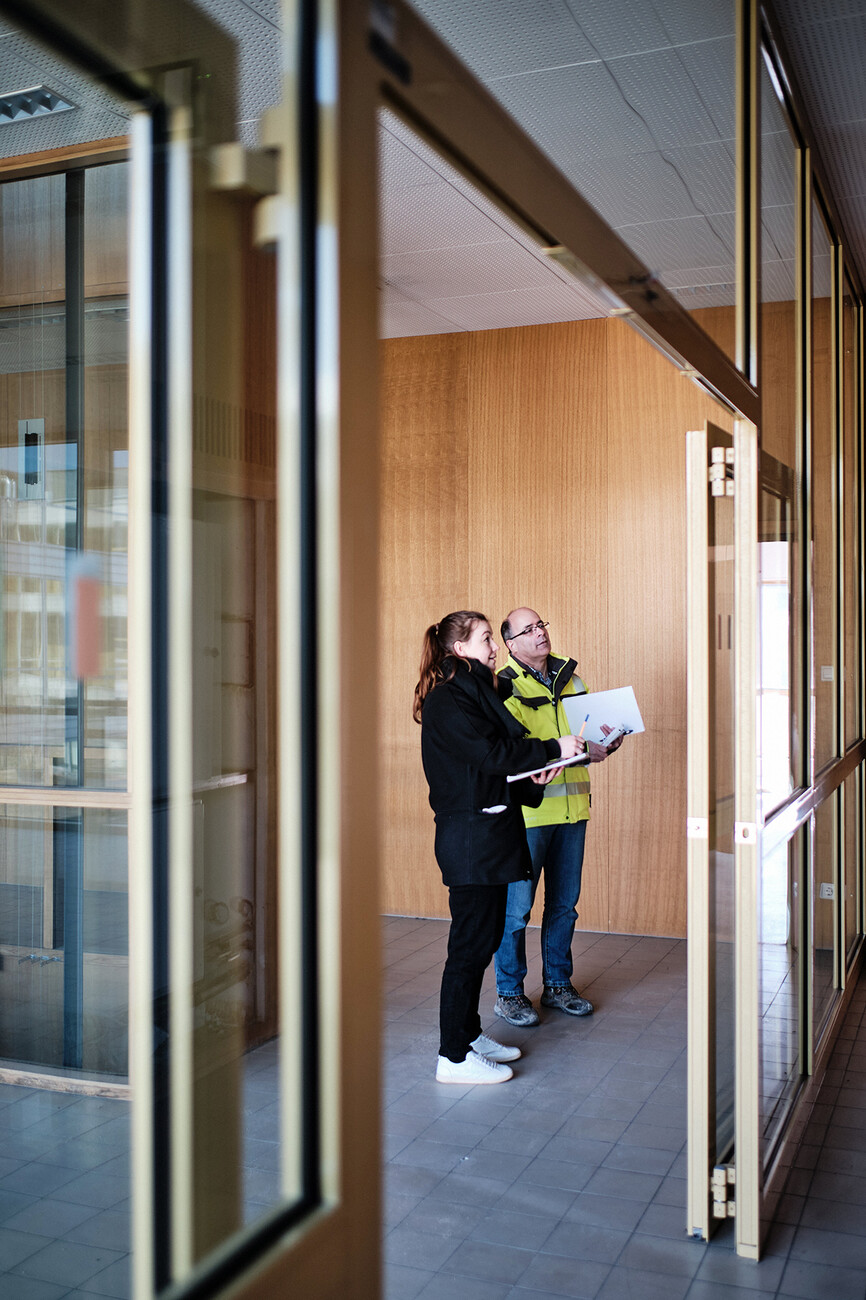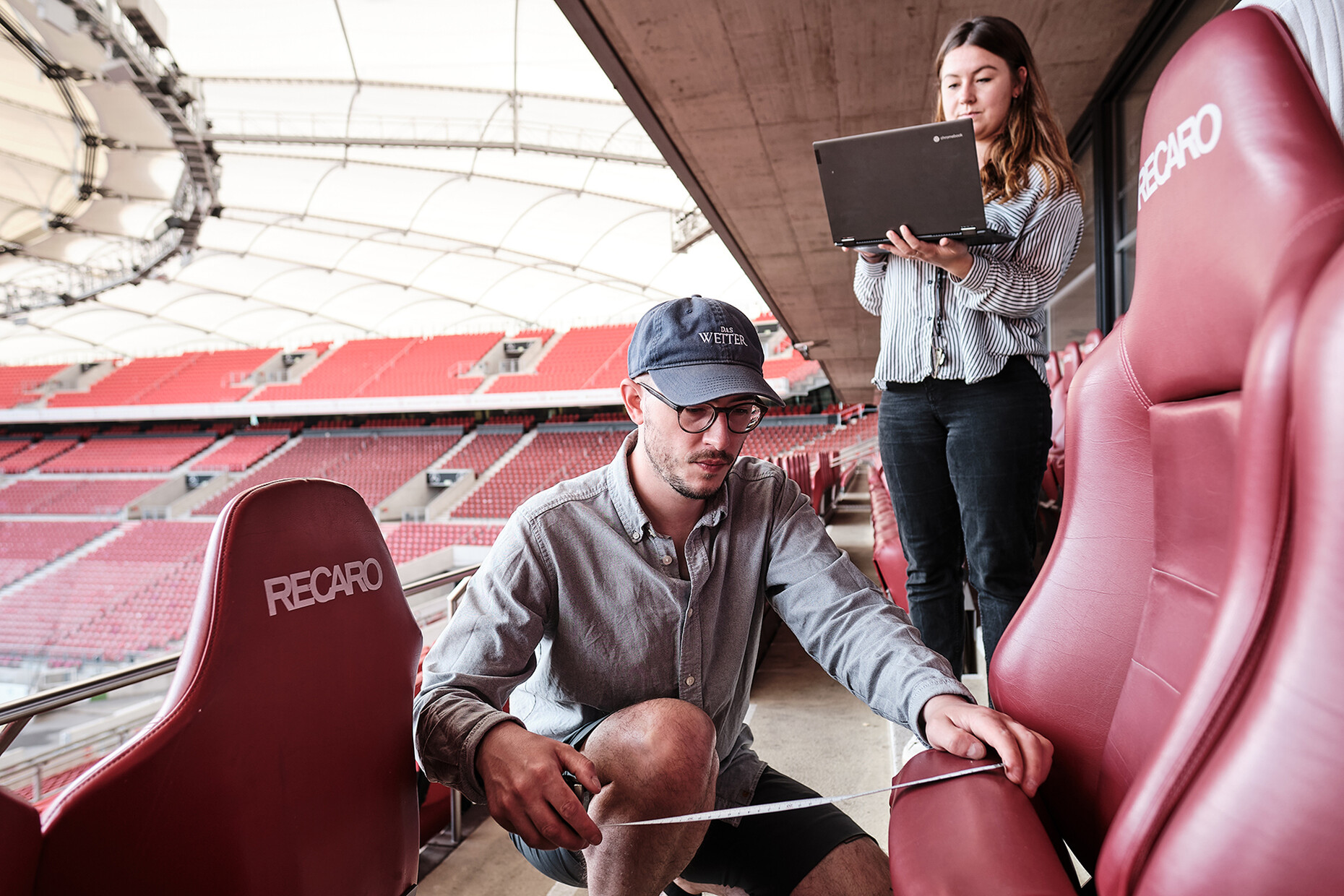Getting to the root of things
Anna Moldenhauer: Concular closes material cycles by checking those building scheduled for demolition for materials that can be reused, and subsequently digitizing what is available for onward sale. How do you find those buildings that can be checked in this way?
Annabelle von Reutern: The good thing is that they come to us. We are contacted by those people who own the facilities or by the project developers. This is an extremely privileged situation. In parallel we find out through the pertinent portals where something is being demolished, converted or rebuilt and we get in touch with the people responsible for the relevant projects.
How can architects and planners use the Concular app to acquire the relevant building materials?
Annabelle von Reutern: The app was primarily developed for taking stock of what is available, and we currently use it internally. After checking the orders that we receive from those who own the existing materials, we inspect the construction site as a team and use the app to record all the parts that are free of contaminants, can be salvaged without being damaged, and are marketable. This selection then goes on sale in our shop as an inventory. We are currently using Shopify for this. Our medium-term goal is, of course, to use it for everything. One third of our team consists of software engineers who are permanently tinkering with the platform. Even now it can be used to produce lifecycle passports using BIM modeling. The next step is then to match supply and demand.
How do you set the prices?
Annabelle von Reutern: The retail price for the building materials is composed of the residual material value plus the extra cost of dismantling it. This means that we need to know from the demolition company at an early stage what prices they charge, for example, not to shred a door but to remove it selectively and preserve its value, to put it on a pallet and transport it to the building exit. This inflates the price as many demolition companies are not prepared to put in the extra work involved. They cannot see any advantage for themselves in it. And although we can refer to past experience, the cost of this service is constantly changing. We then need to figure out what price makes the product marketable and still allows a margin for us. Nobody will pay double the market price for a used product. We are still living in a society where everything hinges on throwing things away and the subsequent environmental costs are not factored into the calculation. Even in public tenders it is the case that the cheapest product wins out. And in this respect a company such as ours is not always competitive enough. Depending on the type of product involved, removing it, checking it over and installing it tends to be expensive.
How are the relevant materials transported to the customers?
Annabelle von Reutern: This, too, depends. Recently, for example, we sold an entire timber frame. There were two buyers and they took care of the logistics and the relevant subsequent treatment themselves. However, it can also be the case that this task falls to us. What we are offering is something new, the relevant processes are not yet established but need to be put in place by means of trial-and-error. They include the question of how to convert the existing infrastructure from a linear undertaking into a circular one. Basically, Concular is a go-between, a pioneer, and a multiplier. We are building up the necessary value-added chain in partnership with those companies that are already on the market.
The trial-and-error method has been very successful for Concular – the projects that the company has successfully completed have included the larger department stores, office premises, and sports stadiums. You have also entered into cooperation agreements with companies such as Lindner. In this case, to specifically remove and reuse their room divider systems. In other words, your projects are very varied. How are the different responsibilities divided up within your team?
Annabelle von Reutern: One person is responsible for a project from the initial assessment up to the stock-taking process. This person then hands the data over to the sales team. We also have architects who focus purely on offering advice on circular procurement and construction methods. We now have a team of just under 40 based in several German towns such as Düsseldorf, Stuttgart, Hamburg and Berlin.
How are things going with Circular House, Concular’s head office in Berlin?
Annabelle von Reutern: The interior fittings for Circular House were designed by architecture practice LXSY in cooperation with Impact-Hub and Transform as the developer. We looked in advance at various building options and Circular House fits in perfectly with our philosophy. At the same time, it is helpful that our own offices are a good example of how to build with existing materials. No less than 70 percent of the materials used in Circular House were being used for the second time. This had advantages in terms of the timeframe, as well, and because thanks to these reuse materials we could adhere to the building schedule and did not experience any delays. Some of the new resources were not available and if they were, then only associated with high extra costs. I often think that the reason for this is that in Germany we do not use existing materials, simply because of some unfounded fear we have. Fear of responsibility, fear that everything will just look like banged-together sheds, fear of the used. I find it incredible how much fear one nation can experience. And how unprepared we are to innovate. I often get the impression that having scruples is what we do best. There are of course exceptions but most people just talk instead of getting going. And this makes me absolutely furious.
“Existing buildings are materials repositories” is one of Concular’s mottos and it is also true that building materials are in short supply in the industry. Nevertheless, the sector only uses around one percent of its materials for a second time. Are there any other reasons, apart from the Germans’ inclination to have scruples, why this should be the case?
Annabelle von Reutern: Generally speaking, we are a privileged nation. For a long time, the only direction was upwards here in the construction and real estate sectors. The building industry didn’t need to make any effort to be innovative. It was able to sell even absolute rubbish for very, very good prices. And if it was possible to earn millions like this why should those involved change anything about the system? However, we need to understand that we are all part of a whole. Indeed, we have alienated ourselves from the world that surrounds us. The very expression “surrounds us”– what does it mean? Humankind is not the center of the universe and not everything revolves around us. I recently interviewed civil engineer and architect Werner Sobek, one of the cofounders of the German Sustainable Building Council (DGNB), and recorded a podcast in which, among other things, we discussed this fact of having become alienated from the knowledge that our planet is precious and its resources finite. Instead of appreciating what we have, we tend to shut ourselves off from the world. We have lost our identity, our appreciation of, and our bond to nature. We think nothing of throwing materials away instead of using them again. We do not think anything about using a “coffee to go” cup for ten minutes and then chucking it. Humans are the only species that produces garbage. Who in fact invented the term and why does it need to exist in the first place? Furthermore, we worry about the unknown and about the fact that circular construction might possibly involve even more work. We all have a lot to do and the value-added chain is complex, building is complex since all the trades involved hang together. On top of all the standards and regulations, having to pay just as much attention to this aspect is too much for many people. And although the existing system isn’t working anymore at least we are familiar with it. The situation that we are currently faced with in the sector is basically utter chaos. We have one foot in one world and the other in another, new one.
What can architects and developers do at this point in order for the cycle to get going more quickly, apart from continuing to stretch the expression “turning point” even further?
Annabelle von Reutern: Political commitment is important, be this within the architectural associations, at the office or with Architects for Future. We need to move away from impotence and towards self-empowerment. To question whether there are no other options available when, in some project or another, an intention is expressed to use plasterboard, for example, or needle-felt. Looking for a new job when your own practice speaks out against sustainability is another way of making a statement. We need to start thinking about where we want to do our work and deploy our resources, as well as about what is in tune with our own values. Another point is personal development. Circular construction did not form part of most architects’ and interior architects’ original training. Nowadays there are a large number of fantastic possibilities in this respect, from webinars to specialized literature such as the recycling atlas and even formats such as “lunch and learn”. Yet another option might be an internal training course in the context of your own company. Sure, this kind of course takes up time but it is worthwhile in the long term. I also think that it is important not to be frightened about making mistakes. We are unfortunately living in a society in which a very dim view is taken of failure. But this doesn’t get us anywhere. Not everything should need to be perfect immediately.
What kind of small steps might take us closer to the objective of circular construction?
Annabelle von Reutern: I usually recommend starting with the luminaires. We have a large number of first-class products on our database, including items by Zumtobel, Trilux and Erco, that can be converted for use with LEDs. Starting with these is so much better than doing nothing. We learn something new from every project we are involved in. Moreover, at architectural competitions it is always a good idea to propose a conversion instead of a new building and to get Concular involved in the planning with the developer. And it doesn’t matter what role we play, we need to work out how we can make a difference and seize the opportunities available.
Before establishing Concular, the same people set up an online marketplace for reusable building materials, together with Restado. This is primarily aimed at private individuals and small companies. Now, with Concular, you are appealing to professional players in the construction industry. What experience will stand you in good stead this time?
Annabelle von Reutern: The most important insight is doubtless that we need to start looking at the bigger picture. It doesn’t help just to pass on the buck to the private sector, since the problem is systemic. And what we need to do is to get to the root of the problem instead of shifting the responsibility onto other people.










